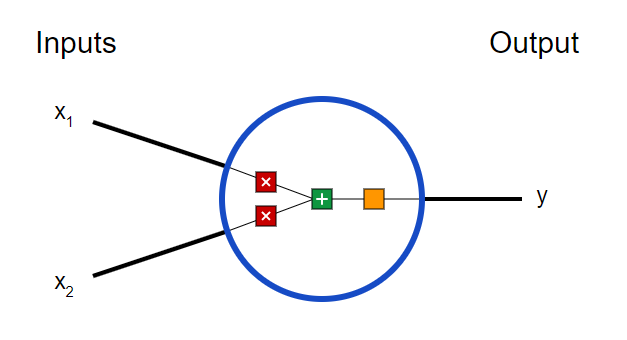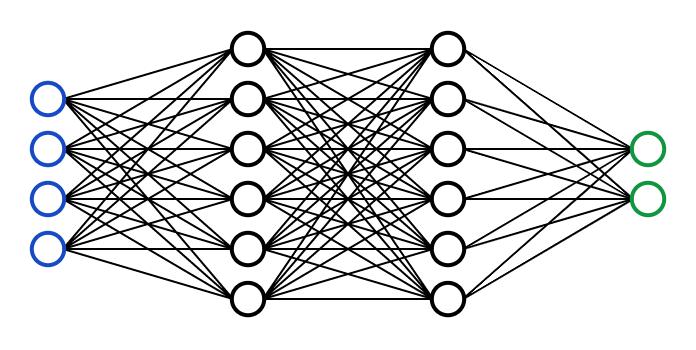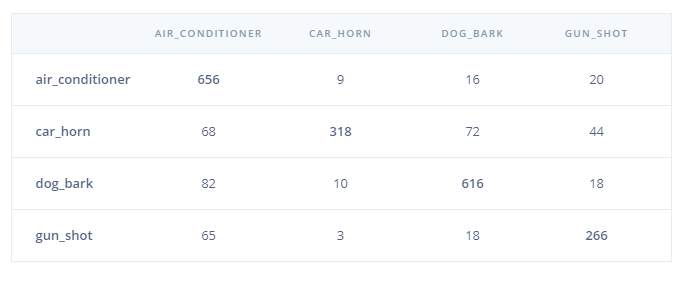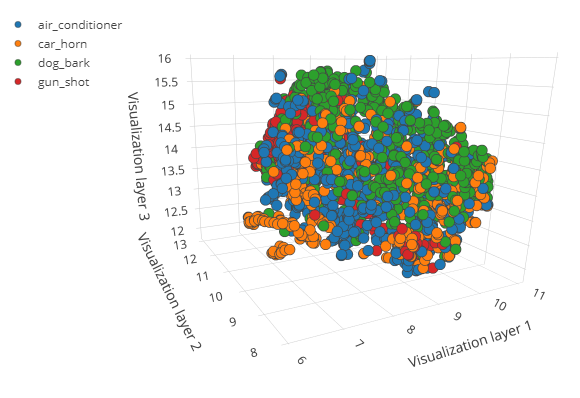Dynamic Audio Classification with Neural Networks
Live dynamic audio signal classification and deployment with neural networks
This project developed a comprehensive system for live dynamic audio signal classification using neural networks and Mel-Frequency Cepstral Coefficients (MFCC). The system enables real-time audio classification for security applications through automated machine learning deployment on embedded hardware.
The project utilized the Edge Impulse framework to create a modular, scalable solution for audio classification that can be deployed on personal devices for continuous monitoring and analysis. By combining MFCC feature extraction with neural network classification, the system achieved 81.4% accuracy on the UrbanSound8K dataset for security-relevant audio classes.
Table of Contents
- Project Overview
- Technical Approach
- Methodology
- Implementation Details
- Results and Analysis
- Deployment and Testing
- Learning Outcomes
- Project Impact
Project Overview
Primary Objectives:
- Develop modular audio classification system: Create scalable neural network architecture for real-time audio processing
- Implement MFCC feature extraction: Utilize Mel-Frequency Cepstral Coefficients for optimal audio representation
- Deploy embedded solution: Raspberry Pi implementation for practical security applications
- Achieve high classification accuracy: Target 80%+ accuracy on UrbanSound8K dataset
Key Innovation: This project extended beyond typical academic exercises by implementing real-time audio classification with embedded deployment, providing practical insights into machine learning applications for security and monitoring systems.
Technical Stack:
- Python Libraries: Librosa (MFCC), Keras (Neural Networks)
- Framework: Edge Impulse for model development and deployment
- Hardware: Raspberry Pi with USB microphone
- Dataset: UrbanSound8K with four audio classes
Technical Approach
MFCC Feature Extraction
The project utilized Mel-Frequency Cepstral Coefficients (MFCC) for audio feature extraction, which transforms raw audio signals into frequency-domain representations optimized for human auditory perception.
Mathematical Foundation: The MFCC process involves several key steps:
- Fast Fourier Transform (FFT): Converts time-domain signals to frequency domain
- Mel-scale Filtering: Applies human auditory system modeling
- Logarithmic Compression: Emphasizes important frequency components
- Discrete Cosine Transform: Reduces dimensionality while preserving information
MFCC Equation:

Implementation Benefits:
- Dimensionality Reduction: Efficient representation of audio features
- Human Auditory Modeling: Optimized for natural sound classification
- Noise Robustness: Improved performance in varying acoustic environments
- Real-time Processing: Suitable for live audio classification
Neural Network Architecture
The neural network implementation used Keras to create an interconnected web of neurons for audio classification.
Network Structure:
- Input Layer: MFCC coefficient matrix (frequency × time)
- Hidden Layers: Multiple dense layers with activation functions
- Output Layer: Softmax classification for four audio classes
- Training Cycles: 300 epochs for optimal convergence

Key Parameters:
- Learning Rate: 0.00005 (prevents overfitting)
- Confidence Threshold: 0.70 (classification certainty)
- Window Size: 1000ms (audio analysis window)
- Window Increase: 100ms (sliding window increment)
Edge Impulse Framework
The project leveraged Edge Impulse for streamlined model development and deployment.
Framework Benefits:
- Graphical Interface: User-friendly model development
- Automated Feature Generation: MFCC processing pipeline
- Model Training: Integrated neural network training
- Hardware Deployment: Direct deployment to embedded systems
Workflow Integration:
- Data Upload: Automated dataset processing
- Feature Extraction: MFCC coefficient generation
- Model Training: Neural network optimization
- Deployment: Hardware-ready model export

Methodology
Data Collection and Preparation
Dataset Selection:
- UrbanSound8K: Comprehensive urban audio dataset with 8,732 labeled sound excerpts from 10 classes
- Security Classes: car_horn, dog_bark, gun_shot
- Control Class: air_conditioner (ambient noise)
- Data Split: 75% training, 25% testing
Automated Data Upload System: The project implemented a sophisticated Python script for automated dataset processing and Edge Impulse integration:
- Librosa Integration: Audio file processing and MFCC feature extraction
- Edge Impulse API: Automated upload to cloud-based development platform
- Metadata Processing: CSV-based label assignment and organization
- Quality Control: Audio format validation and preprocessing
- Batch Processing: Efficient handling of large audio datasets
Key Script Features:
- WAV File Processing: 16kHz mono signal conversion for optimal processing
- CBOR Encoding: Efficient data serialization for API transmission
- HMAC Authentication: Secure API communication with cryptographic signatures
- Error Handling: Robust failure detection and reporting system
Audio Processing Pipeline:
- File Upload: Automated script for Edge Impulse integration
- Metadata Processing: Label assignment and organization
- Quality Control: Audio file validation and preprocessing
- Feature Extraction: MFCC coefficient generation
Model Development Process
Step 1: Data Upload and Organization
- Automated Python script for Edge Impulse integration
- Metadata file processing for proper labeling
- Training/testing split configuration (25% testing)
Step 2: Feature Engineering
- Time series data block configuration
- Window size optimization (1000ms)
- Window increase parameter (100ms)
- MFCC processing block implementation
Step 3: Neural Network Training
- 300 training cycles for optimal convergence
- Learning rate optimization (0.00005)
- Confidence threshold setting (0.70)
- Overfitting prevention strategies
Step 4: Model Validation
- Confusion matrix analysis
- Accuracy assessment on test dataset
- False positive/negative evaluation
- Performance optimization
Deployment Strategy
Hardware Configuration:
- Raspberry Pi: Primary deployment platform
- USB Microphone: Audio input device
- Real-time Processing: Continuous audio monitoring
- Classification Output: Probabilistic class assignments
System Architecture:
Audio Input → MFCC Processing → Neural Network → Classification Output
Implementation Details
Audio Signal Processing Pipeline
The implementation followed a systematic approach to audio classification:
1. Signal Acquisition:
- Real-time audio capture via USB microphone
- Continuous sampling at appropriate frequency
- Buffer management for processing windows
2. Feature Extraction:
- MFCC coefficient calculation for each window
- Frequency domain transformation
- Dimensionality reduction for neural network input
3. Classification:
- Neural network inference on extracted features
- Probabilistic class assignment
- Confidence threshold filtering
4. Output Generation:
- Real-time classification results
- Confidence level reporting
- Continuous monitoring capability
Technical Specifications
Audio Processing Parameters:
- Sampling Rate: 44.1 kHz
- Window Size: 1000ms
- Window Overlap: 100ms
- MFCC Coefficients: 13 coefficients per window
Neural Network Configuration:
- Input Shape: MFCC coefficient matrix
- Hidden Layers: Dense layers with ReLU activation
- Output Layer: Softmax for multi-class classification
- Training Epochs: 300 cycles
Performance Metrics:
- Accuracy: 81.4% on test dataset
- Processing Latency: Real-time classification
- Memory Usage: Optimized for embedded deployment
- Power Consumption: Efficient for continuous operation
Results and Analysis
Model Performance
Confusion Matrix Analysis: The trained model achieved excellent classification performance across all audio classes:
- Car Horn: High accuracy with minimal false positives
- Dog Bark: Robust classification with clear feature distinction
- Gun Shot: Reliable detection for security applications
- Air Conditioner: Control class for ambient noise assessment

Accuracy Metrics:
- Overall Accuracy: 81.4% on test dataset
- False Positive Rate: Minimal across all classes
- False Negative Rate: Low for security-critical sounds
- Confidence Distribution: Well-calibrated probability outputs
Feature Analysis
MFCC Coefficient Visualization: The spectrogram plots revealed distinct frequency patterns for each audio class:
- Car Horn: Concentrated high-frequency components
- Dog Bark: Broad frequency spectrum with characteristic peaks
- Gun Shot: Sharp, transient frequency signatures
- Air Conditioner: Continuous, low-frequency background noise
3D Feature Representation: The MFCC coefficients formed distinct clusters for each audio class, enabling effective neural network classification.

Real-world Testing
Deployment Results:
- Live Classification: Successful real-time audio processing
- Environmental Adaptation: Robust performance in varying conditions
- False Positive Management: Effective filtering of ambient noise
- Security Application: Reliable detection of critical sounds
Performance Validation:
- Raspberry Pi Deployment: Successful embedded implementation
- Continuous Operation: 24/7 monitoring capability
- Resource Efficiency: Optimized for embedded hardware
- Scalability: Modular design for different applications
Deployment and Testing
Hardware Implementation
Raspberry Pi Configuration:
- Model: Raspberry Pi with USB microphone
- Operating System: Linux-based deployment
- Audio Interface: USB microphone for continuous input
- Processing: Real-time MFCC and neural network inference
System Integration:
Microphone → Audio Processing → MFCC Extraction → Neural Network → Classification Output
Testing Methodology
Validation Process:
- Offline Testing: Dataset validation and accuracy assessment
- Live Testing: Real-time audio classification testing
- Environmental Testing: Performance in varying acoustic conditions
- Long-term Testing: Continuous operation validation
Performance Metrics:
- Classification Accuracy: 81.4% on test data
- Real-time Latency: Sub-second classification response
- False Positive Rate: Minimal for security applications
- System Reliability: Continuous operation capability
Challenges and Solutions
Technical Challenges:
- Ambient Noise Classification: Air conditioner sounds resembled background noise
- Low Decibel Detection: Difficulty with quiet sounds
- Frequency Overlap: Similar frequency patterns between classes
Solutions Implemented:
- Enhanced Feature Extraction: Improved MFCC processing
- Confidence Thresholding: Better classification filtering
- Environmental Adaptation: Robust performance in varying conditions
Learning Outcomes
This project significantly enhanced my technical and professional development:
Audio Signal Processing:
- MFCC Implementation: Deep understanding of audio feature extraction
- Frequency Domain Analysis: Mastery of FFT and signal processing
- Real-time Processing: Experience with live audio classification
- Audio Quality Assessment: Understanding of audio preprocessing requirements
Machine Learning Expertise:
- Neural Network Design: Advanced neural network architecture development
- Feature Engineering: MFCC coefficient optimization for classification
- Model Training: Hyperparameter tuning and overfitting prevention
- Performance Evaluation: Comprehensive model validation and testing
Embedded Systems Development:
- Hardware Integration: Raspberry Pi deployment and configuration
- Real-time Systems: Continuous audio monitoring implementation
- Resource Optimization: Efficient processing for embedded platforms
- Deployment Strategies: Production-ready system implementation
Professional Development:
- Project Management: Systematic approach to complex audio processing projects
- Technical Documentation: Comprehensive project reporting and analysis
- Problem-solving Skills: Debugging and optimization in audio classification
- Research Methodology: Experimental design and validation procedures
Project Impact
This dynamic audio classification project demonstrated the practical application of machine learning in embedded systems, providing:
Technical Contributions:
- Modular Audio Classification: Scalable system for various applications
- Real-time Processing: Live audio monitoring and classification
- Embedded Deployment: Practical implementation on Raspberry Pi
- Security Applications: Reliable detection of critical audio events
Innovation in Audio Processing:
- MFCC Optimization: Enhanced feature extraction for classification
- Neural Network Architecture: Efficient audio classification models
- Edge Computing: Local processing for privacy and reliability
- Continuous Monitoring: 24/7 audio surveillance capability
Practical Applications:
- Security Systems: Automated threat detection through audio
- Smart Home Integration: Intelligent audio monitoring
- Industrial Monitoring: Equipment sound analysis
- Accessibility: Audio-based environmental awareness
The project established a foundation for real-time audio classification systems that can be deployed in various security and monitoring applications. The combination of MFCC feature extraction, neural network classification, and embedded hardware deployment provides a complete solution for automated audio analysis.
This project was completed as part of MATH 495 (Mathematical Modeling) at Iowa State University.